superirrealism ™
| digital – sketching
by ale girá
hyperirrealism ™
| digital – sketching
by ale girá
Do you think urban planning & architecture could help improving sustainability, mobility, safety and general living conditions for all?
… landscapes of chance
Before it becomes a reality, it is a project; Before, a thought; Before, an idea; Before, a possibility; Before, a hunch; Before, a chance; Before, it is a reality.
Do you think building more humane and ecologic Urban Environments would be possible? … I do.
Hyperirrealism
explores and interrogates the generation of a new architecture and urban planning for the 21st century. To achieve this, it develops two different working approaches: theoretical and graphical/structural.
Dis-order [a fractal self] researches contemporary human mind architecture, using subjectivity as a way of finding new possibilities in individual an collective identities. Meanwhile, New-order [a global self] presents a vision of the contemporary world from an objective (yet personal) point of view.
Digital Sketching is geometric expression and a synthesis of contemporary human nature: architecture and urban ideas, designs and solutions to contemporary problems, validated by a structural behavior study that confirms their feasibility and stability.
These two approaches to design become part of the actual world as a crystallization of the current historical moment where disorder and order produce ongoing, faster and varying individual and collective (r)evolutions.
It is my intention to focus more on the future than the past, more on freedom and less on indoctrination. It is my belief that theory and practice, dream and reality, innovations and applied technology and art and science, ought to come together to enable personal growth regardless of trends, fashions, established ideologies or moral structures.
In the present investigation I voluntarily opted for an experimental system as a form of acquisition of knowledge.
Today in architecture schools such as the Architectural Association in London (AA), this experimental system is used for the production of architecture with the lowest possible conditioning from prior knowledge. With this system It is intended to form creativity in the situation of liberty, acknowledging that all problems have at least one solution.
My research in such manner has produced a situation of disconnection with respect to existent in the search of my own path not influenced by external conditions. At the end I experiment freely in order to experience without limits what would previously impose references or precedents.
This experimental system produces errors, but experimentation always implies the possibility of errors in the process. Thomas Edison when asked why he failed 2000 times in its attempt to invent electric light said: ‘I have not failed even once, it has been a project of 2000 steps’
Adoption of the experimental system as a way of knowledge acquisition in the situation of untying all that already exists is a personal choice I needed to realize. I felt the need to search my own way of doing and understanding, the need to create my own criteria with which from now I can assess the past, the future. The existing and the upcoming based on own experiences, ideas, and knowledge. It is my belief that this is the only way knowledge produced by other people from past, present and future can be assimilated in a personal and true manner.
However, one cannot say that I have acted without prior knowledge. Knowledge I have used is based more on open and non-coercive systems, that permit experimentation without passing the filter of a-priori valuations, than onto systems with limits imposed by correctional willpower, or the prejudice of realistic, traditionally imposed knowledge only established as true, limiting freedom of thought and action, ultimately leading to non-conditional experimentation to itself by external factors.
Knowledge does not consist in the adoption of a determined and exclusive line, but in the integration of different factors, including conflicting ones, that conclude in an integral, inclusive knowledge. Today we see how division and fragmentation affects all spheres of humanity leading to extremism and confrontation between tendencies, tastes, preferences and realities.
Even political and social systems are aligned to this tendency of confrontation between individuals, social groups, policies, and geographical or religious boundaries.
Architecture should produce knowledge that integrates differences, even from opposing and disparate perspectives. It must integrate science, art, ecology, individuality and collectivity … Architects have to integrate in their projects as many factors as possible, without exceptions.
Is science important? Yes. Are aesthetics important? Yes. Is ecology important? Yes. Is individuality important? Yes. Is collectivity important? Yes.
True knowledge and wisdom are integrated. Division between different viewpoints only leads to self-restraint, exclusion of complementary knowledge, and confrontation between different human facets that would not be generated if them all were considered necessary and complementary to each other, for the production and enrichment of knowledge from distinct perspectives, reducing tension and producing more and better understanding of reality. This amplifies the own boundaries of architects and their projects.
Knowledge should not self-impose barriers or limits. On the contrary, it must feed on the different, on the apparently anorexic and contrary. It has to pursue integration, not exclusion, to pursue what is unlimited, and not what is limited.
There is no worse service to knowledge than certainty of truth. And no better service than integration of differences.
My system of thought and action is based on what I call ‘contrary philosophy’, which is to do and to think the opposite of what is considered to be correct. This form of thinking and action expands boundaries of ‘self’ by not admitting its internal and external constraints.
This system often exists in children’s minds. Children learn by experimentation, by rebellion against their constraints. This form of learning is based on internal rebellion to all that exercises limitations in development, authority, by opposing their will to exercise unlimited freedom.
‘Real’ world is full of limitations. The i-reality of children is a reaction against their limits. By ‘irreality’ children learn not by imitation and acceptance of imposed limits, but through imagination free from constraints and limitations. It allows them to experience possible future and past situations at present, at their imagined present.
This system allows children to acquire knowledge and prepare for future ‘realities’.
Contrary philosophy allowed me to acquire technical and non-technical skills to exercise my future personal and professional career in a situation of liberty, with the capacity to contribute useful resources to other professionals and people.
The experimental system of knowledge acquisition involves the development of personal and distinct skills to other people favoring contribution and complementary production through difference and individuality.
At present we see how negative criticism is made on different architecture just because it is different. It is my belief we should focus criticism to the majority of buildings constructed recently that are indifferent, not adding anything to the architectural panorama. To buildings that are exclusively based on economic and market-related criteria with no relation to scientific, technological, aesthetic or ecological research. To buildings that have clogged our cities and environment.
It is my belief that we should not negatively criticize architects who have opted for the path of differentiation, but to all those without courage or capacity to generate their own way of making architecture. To those who with indiscriminate and undifferentiated activity have devalued and degraded the architectural environment and quality of our urban surroundings. These architects, unaware of new technologies in the world at present, and their new aesthetic and scientific implications, continue to produce projects in the same way or even worse than the ones made before of the advent of new technologies. They fill our lives with de-contextualized, reactionary, harmful architecture.
They are protected and shielded by insufficient laws and regulations of minimum architectural standards that permit them to make architecture with no quality and no vision; Unjust and antisocial; With the permission of governments, in the pursuit of economic benefits that are particularly abusing; In the expense of ruining and indebting individuals who compose society; Taking advantage of their longing for a better quality of life encouraged by consumerism and marketing, tools of manipulation and control of people’s needs and desires.
Negative criticism should be directed to these social agents. Among them are many architects without ethic who exercise their harmful activities with impunity at the expense of the most vulnerable.
Committed architecture is always different, not indifferent.
My form of thinking and action is essentially inductive. There are numerous theories and definitions of this type of thought and action, for which I have little knowledge and awareness. However, I share the vision of the inductive method as a form to draw general conclusions based on particular observations. I also share the vision that it is a method of probability, which does not ensure absolute accuracy of assumptions or conclusions.
In favor of hyperirrealism and its architecture it should be noted that it has fair acceptance by increasingly more people of all types, ages, cultures, education, taste and inclination, who favor daily the idea of reach beyond myself and my limited knowledge, my limited environment, and the specific circumstances in which it was produced.
I also would like to express my artistic vocation that utilizes architecture as means of expression and experimentation. It claims both the artistic character of architecture as much as the scientific. Renunciation of any of these two facets devalues its integrated character and knowledge as a producer of reality and ‘irreality’ that reflect human beings in a particular time, with their needs and dreams.
URBAN PLANNING & ARCHITECTURE
Should Urban Planning and Architecture be separated? I wonder when we began to consider them as separate.
In the distant past, Architecture and Urban Planning formed a unity of actions. Cities were configured by production of Architecture. Urban Planning was not yet a discipline. It simply occurred while Architecture was constructed. Urban structure and Architecture formed a sensual unity.
Much later, Urban Planning was reinvented as a discipline to shape the form of a city, as Architecture was thought simultaneously to Urban Planning. Urban Planning was carried out through Architecture. Both shared the same (development?) project.
Now, we have Urban Planning on one hand, and Architecture on the other. You can see how Urban Planning does not guarantee Architectural quality, and how good Architecture has to fight with Urban Planning regulations that often hamper its very realization.
There are possible advantages on the separation of the two disciplines. Each one of them solves some distinct problem types. But if we tried to bring both disciplines closer together, we might be able to better control our cities and their resultant environments. Urban Planning would be more real, and Architecture would be closer to urban reality.
All projects need their own degree of freedom to adapt to new conditions throughout time. However, I believe Architecture and Urban Planning must be closer to each other in order to successfully reach their common objective: A better reality.
‘Better Reality’ refers to a certain result that ensures greater coherence, and better response to factors such as:
> Spatial organization
> Temporal organization
> Sense of unity
> Generation of identity
> Generation of certain environment
I believe this can be achieved through joint work of Urban Planners and Architects, through integration of Architecture and Urban Planning, and through sharing of the common objective of both disciplines, for high quality of cities and buildings. This will ensure quality of environments, from smallest to largest, and vice versa.
I further believe that the solution to Urban Planning is in Architecture, and that the solution to Architecture is in Urban Planning. Let´s do Architectural Planning and Urban Architecture.
ACCUMULATIONS
>Modular City
By modular construction we can create architecture and urban planning as a unity, comprising from the large urban scale to small buildings parts. This assures better integration between both disciplines to achieve more and better control over the result: A coherent complex system that responds as a whole to questions such us identity, spatial and temporal organization and sense of unity.
>City Engineering
Engineering, urban planning and architecture should work together. By joining these three disciplines we can propose, develop and build new city solutions. New city concepts need an integration between new ideas and new construction systems.
Cooperation between engineers and designers could bring new solutions to city environments for a better adaptation to nowadays and future ways of living.
>Structural Security
Structural security in high rise buildings can be reached by buildings complexes that behave as a single, low slenderness structure. This type of structures also facilitates communication at different heights.
These complexes also generate a sense of community and a sense of unity at architectural and habitational levels.
>Inspired by Nature
We can take nature as our first design teacher. In this way we can create more natural environments, what would in turn make as feel more and better adapted to our natural origins and surroundings.
‘Building nature’ is a new challenge for creation of new ways of living according to natural values in a harmonious relationship with our environment.
>Community
Generating community feeling is today a new challenge for architecture and urban planning. This can be done by buildings that potentiate a sense of unity. Community feeling and belonging is necessary for a more humane and natural way of living, in accordance to our social needs. This would increase our cooperation capacity as a growing social and functional organism.
>Autonomy
New communities and architectural and urban environments need autonomy for a better functioning as an organism. This autonomy could be reached by self-sufficiency in terms of social diversity within the community, as well as coverage of all its own necessities: a kind of self-sufficient eco-system in a natural and organic sense.
>Diversity
‘There is mounting evidence that biodiversity increases the stability of ecosystem functions through time… Diverse communities are more productive because they contain key species that have a large influence on productivity and differences in functional traits among organisms increase total resource capture.’
Architecture and urban planning diversity potentiate growth and stability of the ecosystem.
>Macro-City
Possibilities of nowadays construction include generation of macro-structures for creation of a new type of city: the macro-city.
The macro-structure would contain streets, public spaces, private spaces, services, communications, etc. … a macro-city where all our needs would be included into a general structure full of possibilities for a better adaptation to present and future needs.
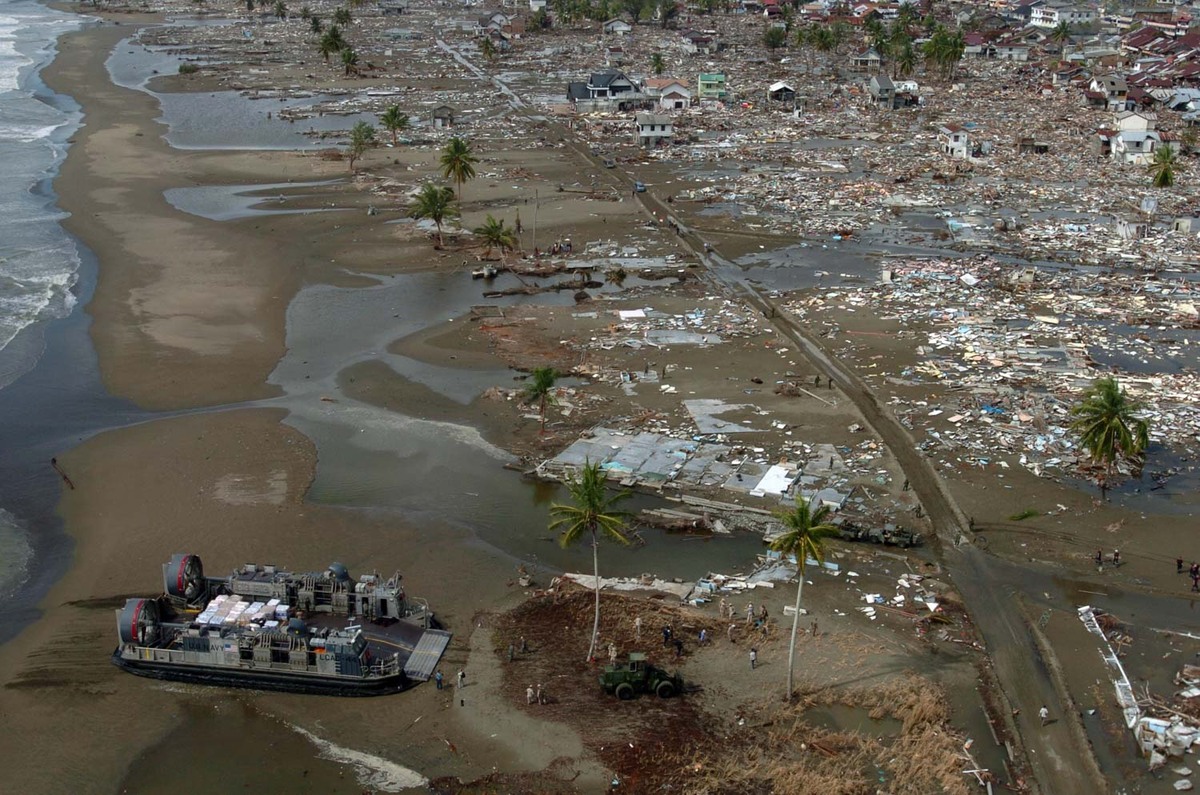
Due to the rise in sea level it will be soon necessary to leave the current coast settlements, abandon many cities, and create new urban urban environments inland.
Climate change heralds a rise in the sea level for the next century of up to 2 meters, and an exponential rise over the following centuries. Nowadays, the majority of cities and urban settlements are located on the coast, hence they will be affected by this phenomenon.
This and the resulting large mobilization of the population causes the need for planning and building new cities inland to accommodate those populations.

Although there are regulations for the construction of buildings that guarantee stability in the face of catastrophes, high-rise buildings are typically unstable due to their slenderness. Regulations for construction calculations for these types of situations are based on estimations of probability, but cannot guarantee their validity in extreme circumstances, unlikely but possible.
High population density increases the collective risk of natural disasters, such as earthquakes, hurricanes, tsunamis, etc.
Large agglomerations of people inevitably lead to increased collective risk of natural catastrophes. To mitigate their effects we must build cities that are capable both of receiving high population densities and minimizing the consequences of these natural phenomena.
At the present time, high population densities imply unsafe buildings due to their high slenderness, which makes them extremely vulnerable to the horizontal efforts they are subjected to in case of earthquakes, hurricanes, tsunamis, etc., making them dangerous for their inhabitants and those of the surrounding buildings that can be affected by a domino effect by collapsing neighboring buildings due to one of these natural phenomena.
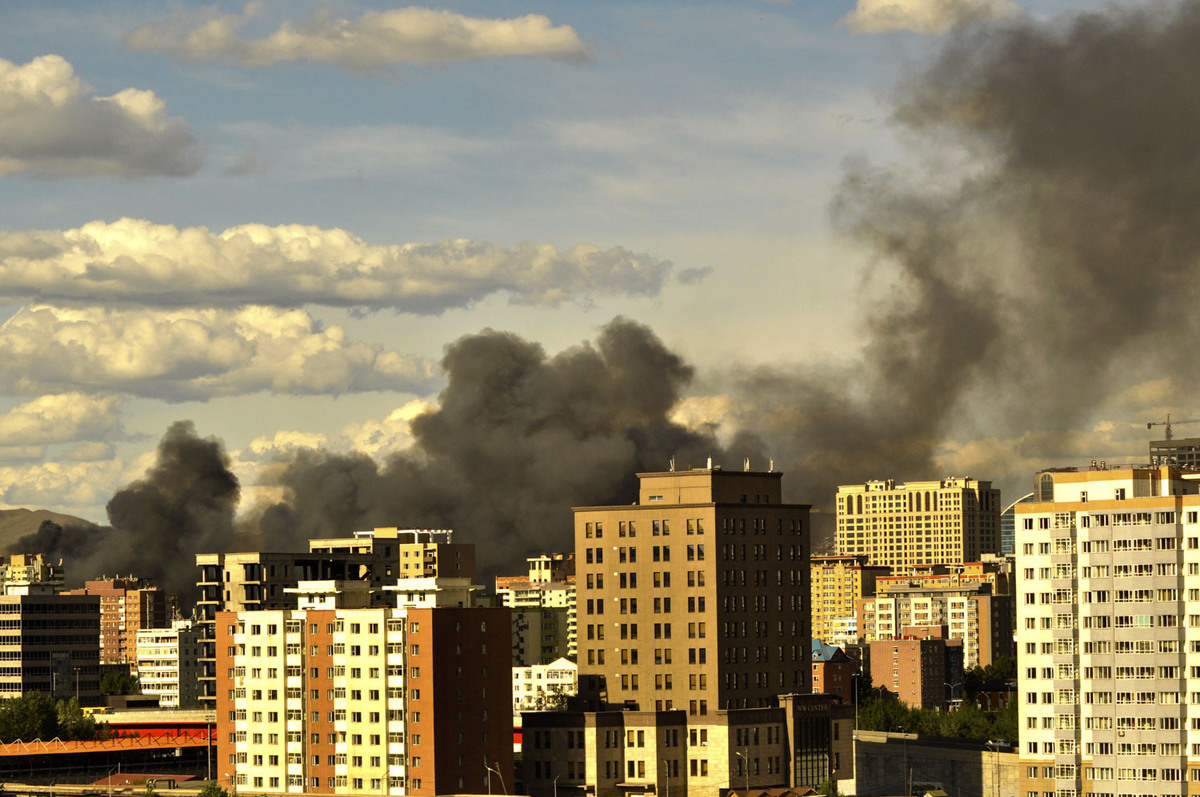
Fire is another threat to the safety of inhabitants of our cities, and even more so for those in slender buildings as they may find themselves trapped if a fire breaks out on a lower story. Today there are numerous detection and extinguishing systems, but high-rise buildings are more difficult and slower to evacuate. In our current cities the buildings are very close to each other, which also means a high risk of spreading easily thereby affecting large areas, both in the case of a fire occurring inside a building as well as outside, reaching outlying urban areas.
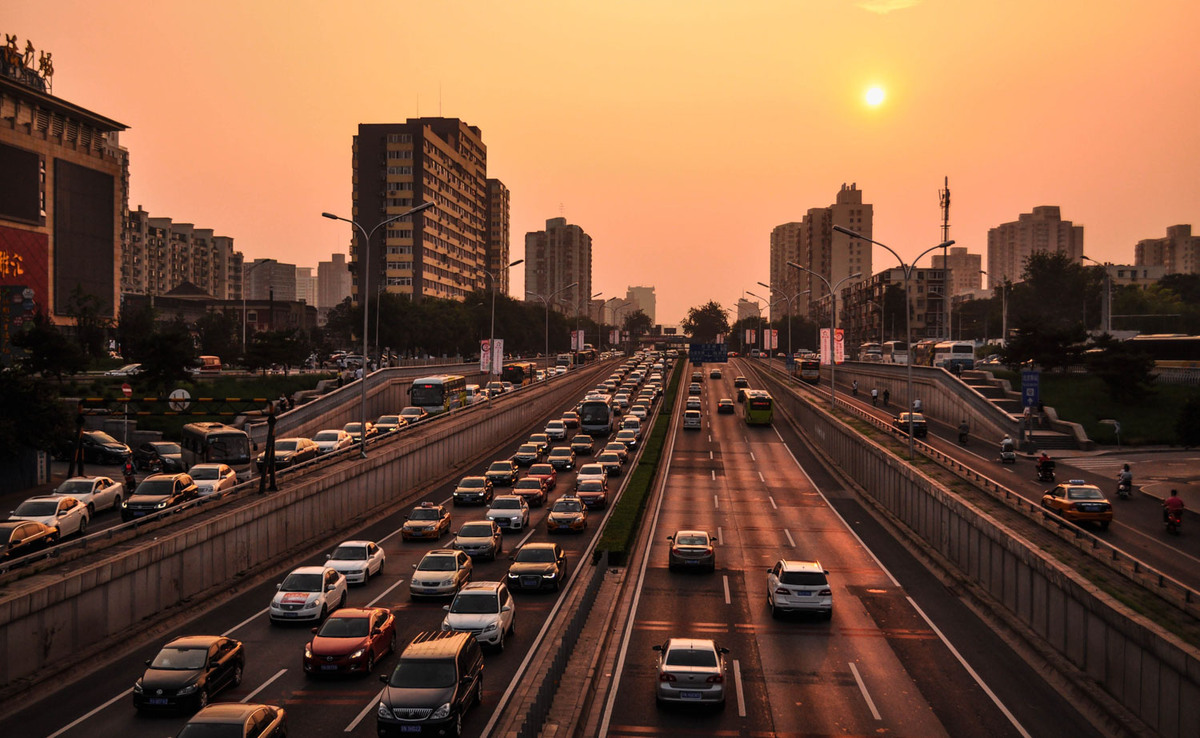
The overabundance of uses which land undergoes provokes conflicts of interest that become multiple unsurmountable barriers. Above all, the large transport networks (private, railways, etc.) and large infrastructures in general place limits on wide areas of our cities, which isolate entire suburbs and provoke disconnection-noncommunication resulting in many cases in degradation, lack of development/maintenance and finally, poor conditions of life and lack of opportunities for inhabitants.
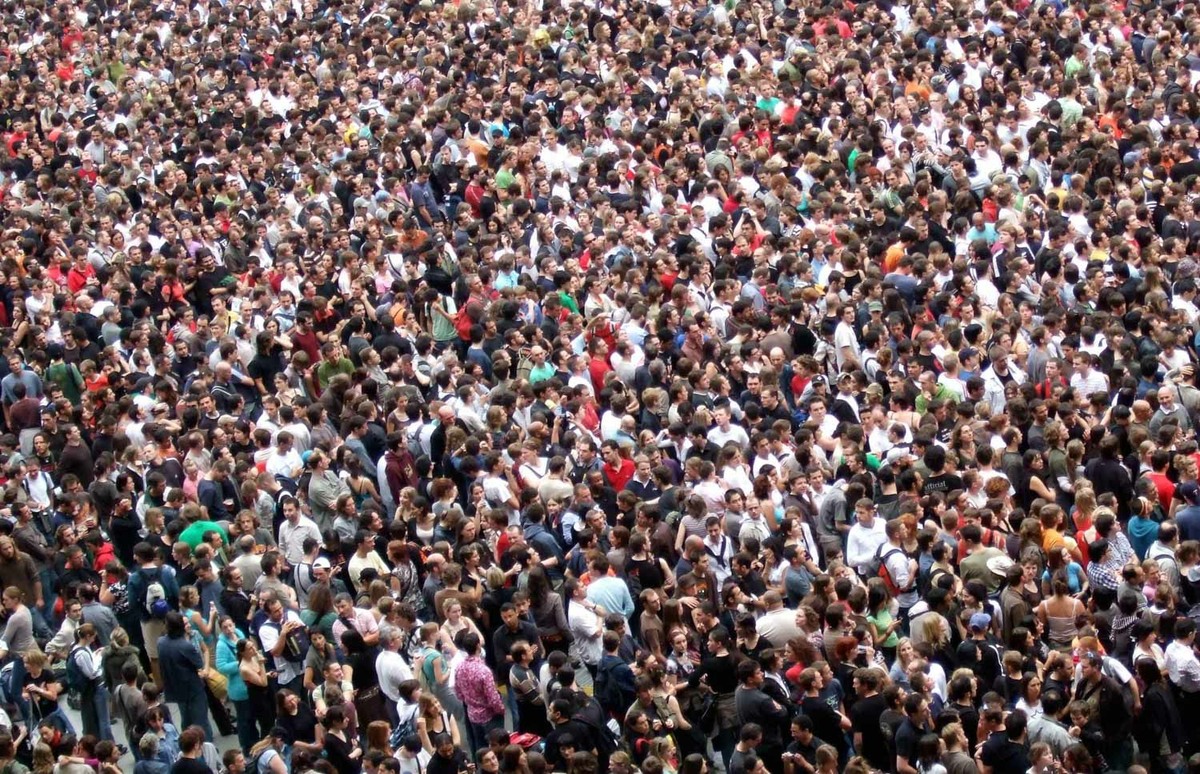
Urban populations will continue to grow. This will increase problems of transportation, contamination caused by it, time loss, and life quality caused by large, slow uncomfortable traveling conditions.
Pollution in cities is mainly generated by vehicles, whose numbers have risen sharply and will continue to increase. This increase leads to a worsening of the problem of pollution, as well as other collateral problems, due to the daily transportation of people, such as loss of time, loss of comfort and, ultimately, loss of quality of life for large segments of city dwellers.
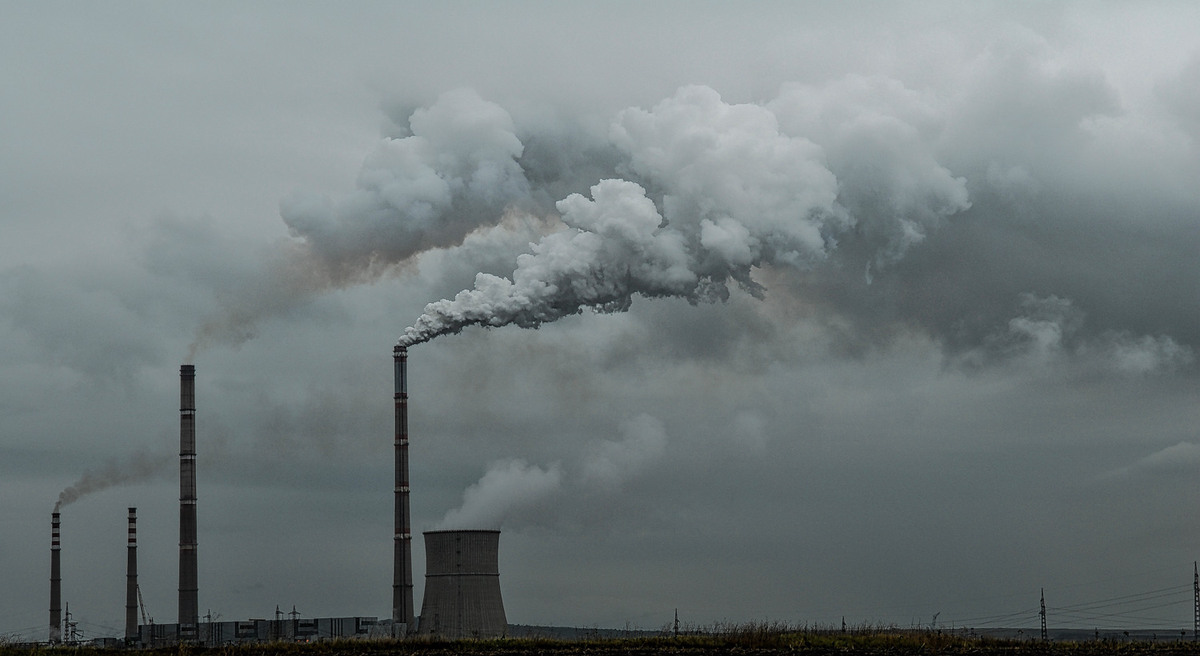
The majority of current societies live both sides of the same coin: overproduction. This phenomenon, born of the need and will of economic growth at any cost has led to the generation of large amounts of waste (solids, liquids and gases) that pollute the environment, often irreversibly. The pollution problem is a problem of lack of awareness, both by many governments and the general population, all of whom are increasing the problem on a global scale beyond physical, geographical and political borders.
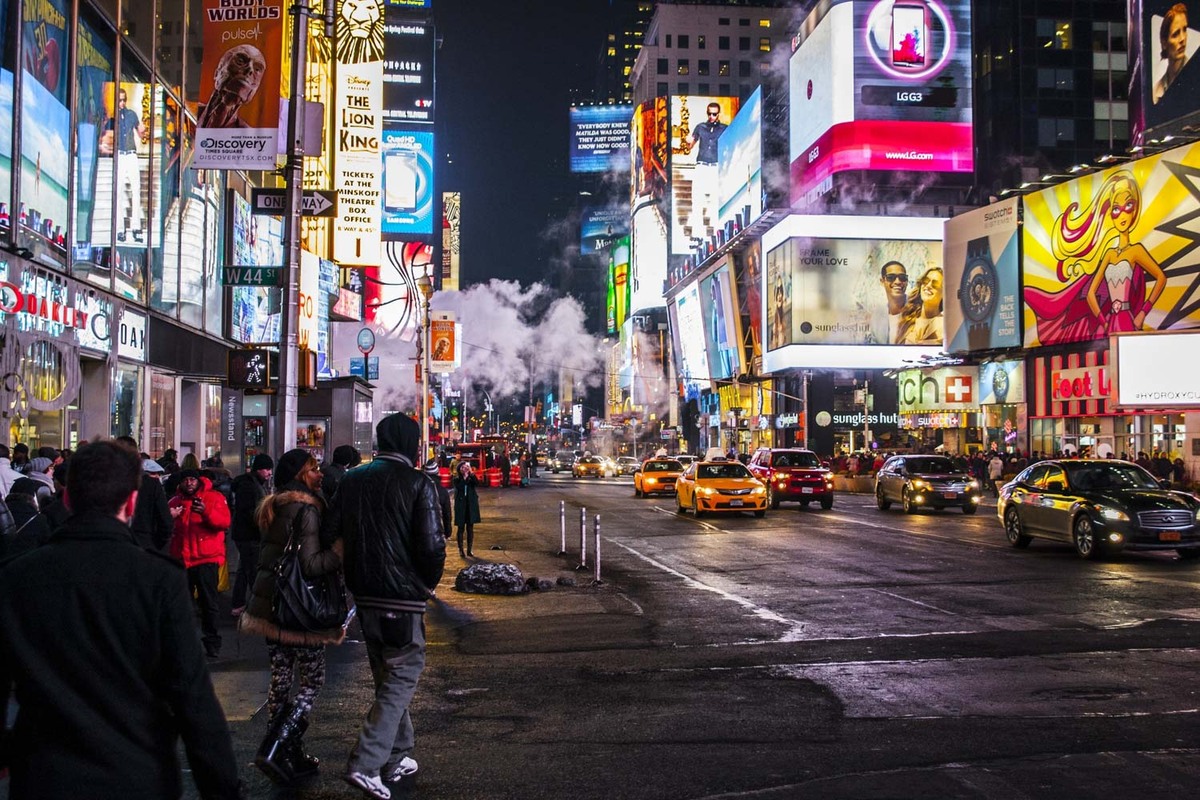
Surrounding us all we find urban environments in which visual pollution reaches an extreme invasion of public and personal space, objecting us to a high impact of stimuli, sometimes both disturbing and intimidating. This phenomenon is once again a product of imposing economic growth and consumption over any other value and individual/collective right. Besides this, visual pollution is not a temporary problem, but rather it is produced continuously both in public and private spaces, by means of the overabundance of the mass media, affecting and influencing people of all ages.
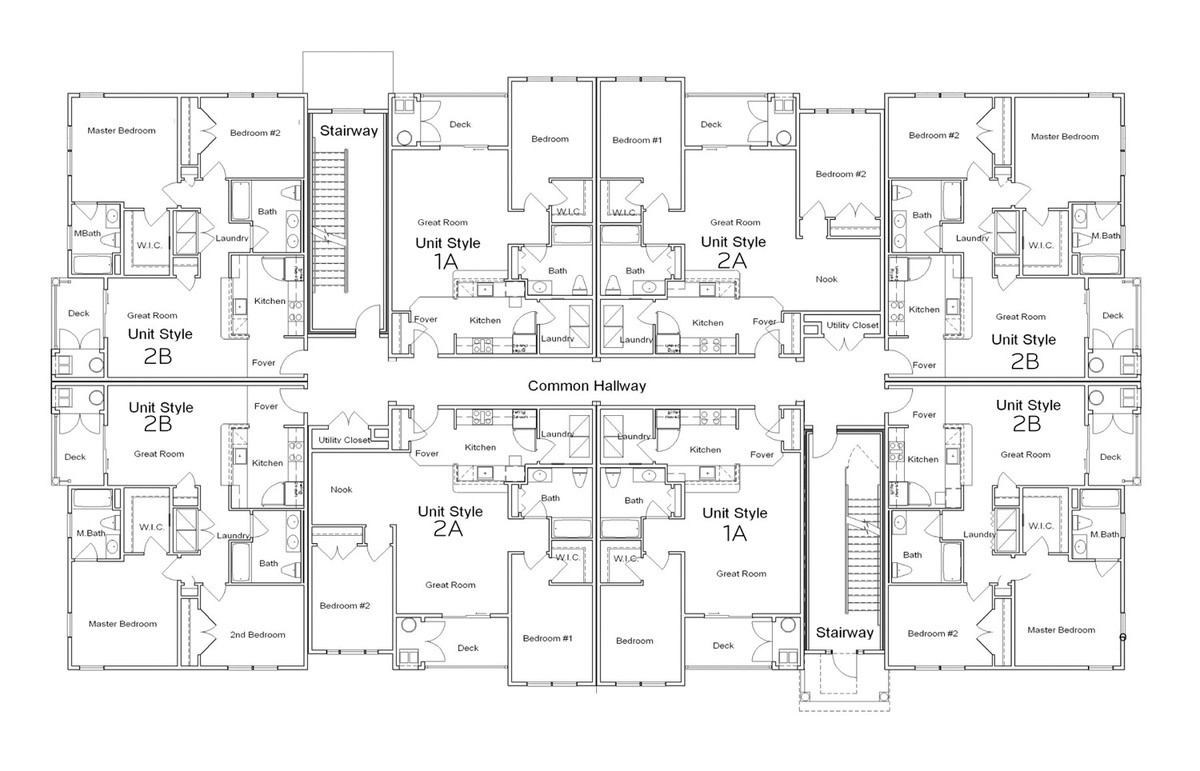
Population density in medium and big cities will increase, reducing, both public and private, living space per inhabitant.
High population densities are associated with a significant reduction of living space due to the decrease in the amount of private space in the design of the building in response to a high population demand.
The value of the home as a space for personal and family development has been deteriorating to unacceptable limits. Today there are many homes around the world that are subhuman, both in new as well as existing buildings, since they do not come up to the necessary standards for the wellbeing and development of their inhabitants. The concept of home has been reduced to that of a minimum cell (unit) without any spatial value, and with the restricted functionalities of cooking, eating, living (space for television viewing), washing and sleeping. There is no room for any other uses or human needs and even these functions are designed for the minimum space, favoring economic interests over human needs.
Not only is private space diminishing, public space is also becoming smaller as population density increases.
This causes the proportion of public space per inhabitant to diminish progressively at the same time.
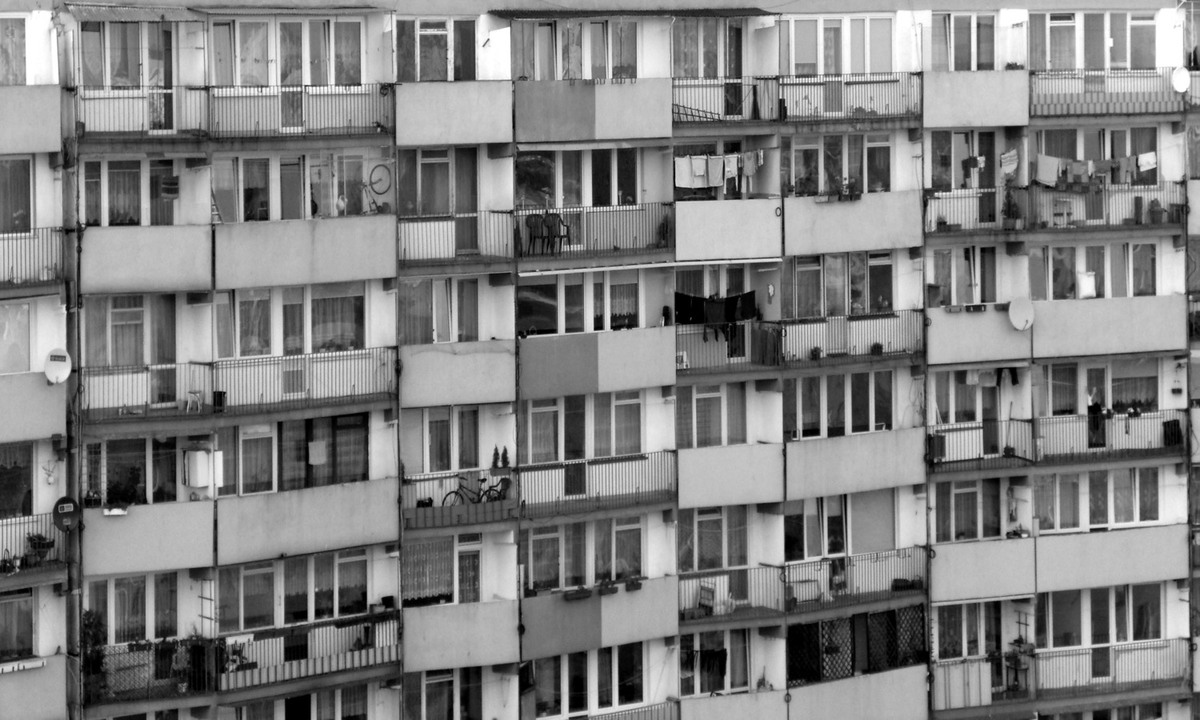
Generally, over the last century, and in particular the last few decades, the housing market has undergone the ravages of speculation more than any other economic sector. Speculation in the housing market has meant great business for those agents involved in the building and selling of property, and faced with the passivity of many governments who have not established anti-speculation fiscal measures or regulations which guarantee a good quality, this has degraded the quality of building construction in order to line their own pockets to the maximum. The housing market has subsequently offered low quality at extremely high prices with no alternative for the consumer.
Architecturally, this poor quality has resulted in poor construction, lack of aesthetics, lack of privacy, poor ageing of buildings, bad ventilation, insufficient natural light, poor design features, decadent living conditions, etc.

Millions of people are mobilized to look for more favorable living conditions for them and their families. These people travel to countries and cities with better economic conditions to find a way out of their current situation and a better future. The cities where they end up are not adapted in many cases to offer an alternative lifestyle for this enormous demand, so that the situation for many of them does not improve, and may even be worse than their original one.

The shortage of public space and its main use as support for vehicle traffic will limit the possibility for it to be used and enjoyed by the public.
The large spaces needed by vehicle traffic directly affects public space and its use for any other purpose.
Both the transit of vehicles and their parking require large amounts of space that has to be taken directly from public space. This fact progressively reduces public space as transport needs and quantity of vehicles in cities increases.

Marginalization and social exclusion are two of the greatest curses of modern societies, from which arise problems of safety, economics, affection, behavior, knowledge, self-esteem and self-realization for people in these circumstances. Many people currently suffer from marginalization and social exclusion in terribly adverse living conditions and with little, if any, chance of escape. These problems, whether looked at from an altruistic or selfish point of view, require urgent solutions, given the gravity of living conditions, before they reach a point of more serious social conflicts if that is possible.

The great number and extension of conflicts that exist today in the world (ideological, moral, economic, etc.) very often turn into violent ones. More and more often these differences are interpreted as a threat rather than a form of wealth, which ends up in violent and aggressive and/or defensive behavior, paradoxically in a world ever more plural and varied, in which the mixture is the essence of our time. This fact is so both at an individual as well as collective level, on a personal as well as governmental level, generating internal and external conflicts at all levels in current societies.
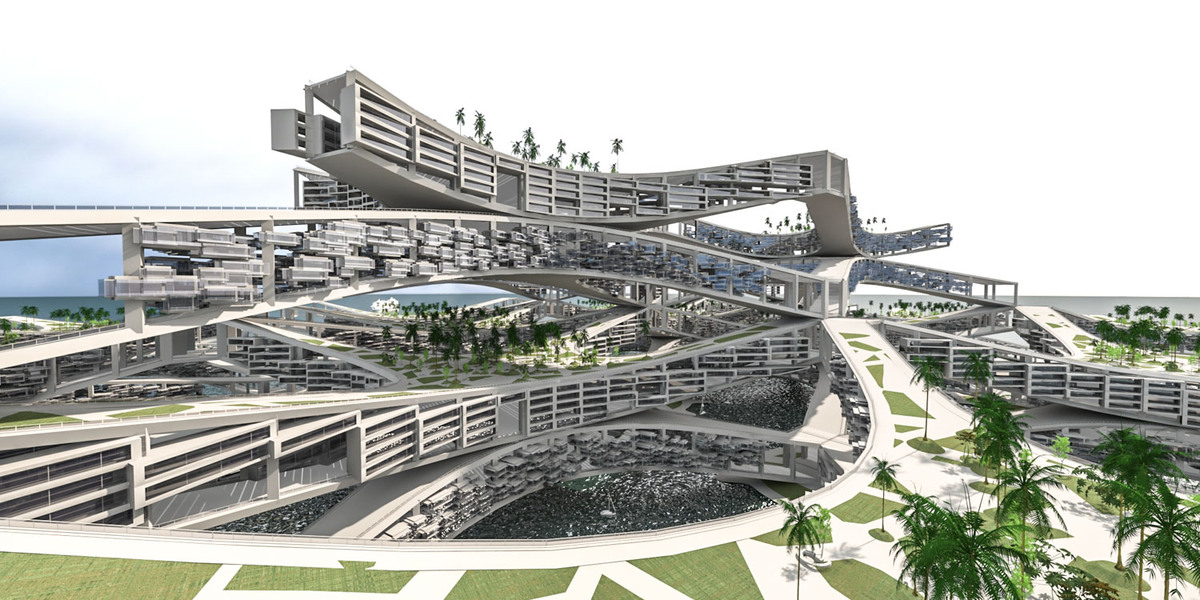
Building new cities through macro-structures allows their height to be increased in a safe way when faced with natural disasters, such as earthquakes and hurricanes, as they have the structural behavior of low-slender constructions. Besides, this type of structure allows horizontal transportation in separate heights, thus fostering communication, shortening distances, and increasing mobility.
In order to guarantee safety and facilitate transport within the macro-structure, there must be a separation of vehicle and pedestrian traffic on different floors at each level in all directions. In this way system collapse is avoided and free traffic-flow is enhanced.
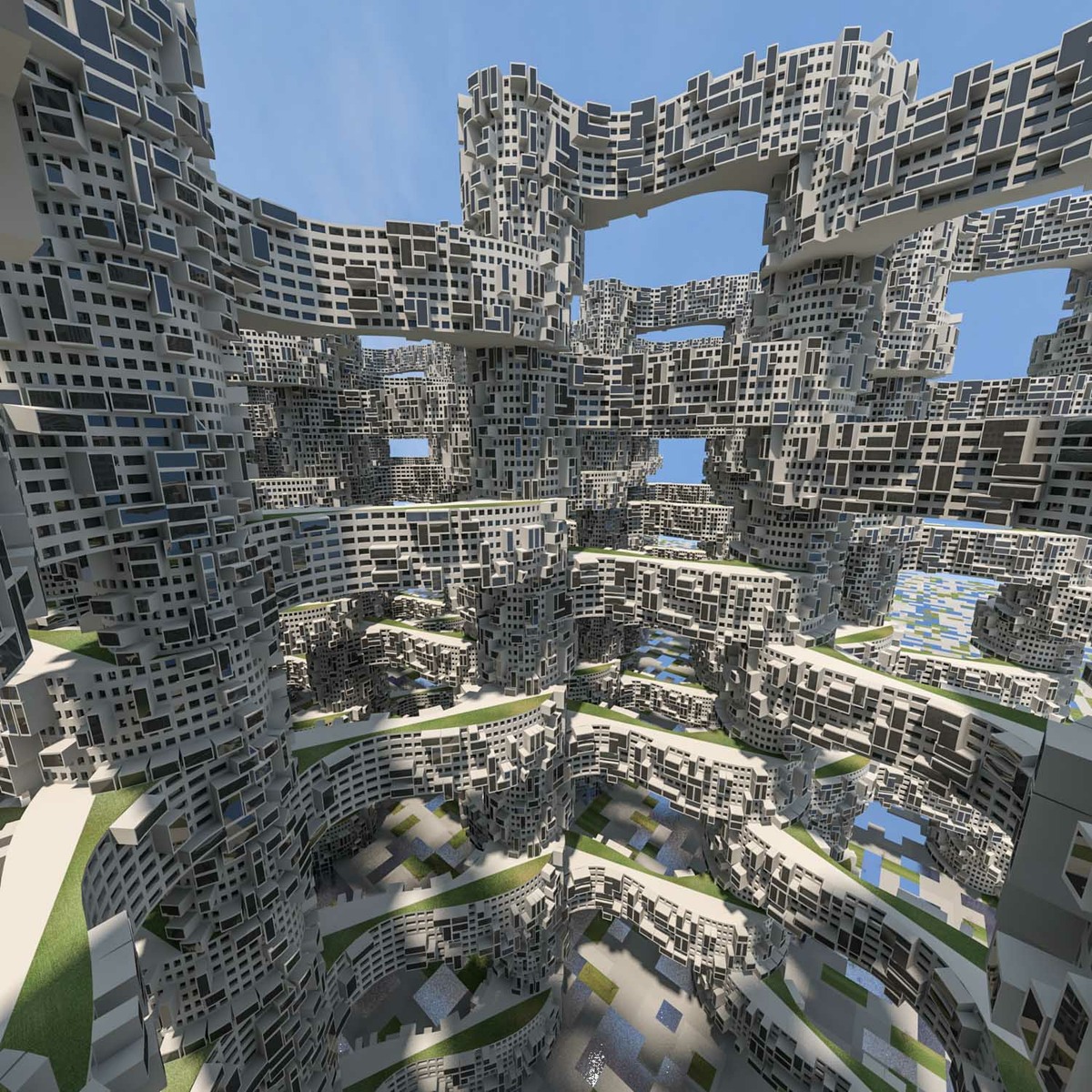
The creation of macro-structures with 12 meters clearance between levels permits and favors the creation of micro-architectures in their interior. Macro-structures create a macro-structural spatial framework for the development of architecture within them that works alongside specific usage needs.
This means replacing traditional urbanism with macro-structures containing micro-architecture. Macro-structures are responsible for favoring overall structure and services and micro-architecture provides the adaptation to specific and particular needs of each use or function within the macro-structure.
This micro-architecture must be controlled by means of regulations that guarantee good quality construction, as well as avoiding the production of both visual and acoustic pollution.
In order to guarantee health and avoid pollution in general, macro-structures must include systems of waste collection for posterior treatment and recycling.

Constructing self-sufficient buildings – that will lead to a lesser dependence on vehicle transportation – will considerably reduce problems of surface traffic excess and therefore, pollution.
Traveling, by vehicle or other means, is due to the daily necessity to commute to/from work, service places, and others. If buildings were self-sufficient, i.e. if they contained all these uses within them, their inhabitants would not need to move, therefore the amount of movement would be minimized, thereby reducing pollution of cities generated by transport. This would also improve the quality of life for people; minimizing the daily need for long and uncomfortable commuting would increase users’ free time and comfort.

Communication and transportation are fundamental for economic activity. We ought to replace the concentric pattern of our cities with isomorphic, poly-centric structures that will encourage, facilitate, and accelerate communication and transportation.
The concentric (mono-centric) structures of our present cities are due to radial growth. This model produces huge problems in terms of transportation and communication.
To solve this problem we must build cities whose structure are polycentric, isomorphic. This type of node structure is the one that allows greater fluidity and enhances transportation and communication.
Promoting transportation and communication is essential to facilitating economic growth.
For this purpose we must adopt structures that facilitate and favor transportation and communication to the maximum, for which the polycentric and isomorphic structures are the most appropriate, as demonstrated by the functioning of the Internet.

At the present time, technology of self-driving vehicles is evolving rapidly. This technology has many advantages from the point of view of efficiency, comfort, and transport safety.
Cities whose structures respond to precise, specific geometric patterns facilitate the implementation of this type of transport and improve general mobility.
In addition, self-driving vehicles allow the creation of a general public transportation service, since vehicles can be used as taxis without a driver, which greatly reduces the number of vehicles needed. In addition it will practically eradicate parking problems.
Both features would drastically reduce the problem of pollution, and increase the availability of public space for uses other than car parks.

In high-rise buildings transportation is vertical. Distances between means of transport are less than in conventional structures that are fundamentally horizontal, which leads to distance reduction, organization and much more efficient transportation.
Current buildings and transportation are mostly horizontal. This means that traveling takes longer.
High-rise construction involves vertical transportation, that in terms of distances are smaller, since the measurement of a storey in height is much less than its horizontal dimension. This results in shorter distances and faster movement.
In addition, this type of vertical transportation can be organized more efficiently according to demand and time requirements through computerized systems, which in turn facilitate mobility and shorten transportation times.

Generation of public space through construction of buildings that free up maximum ground level space for public social use, while taking in high population densities.
Macro-structure construction allows maximizing the ground level for use as a public and social space.
Macro-structures can be supported at points distant from one to the other. This results in a practically full release of ground level, allowing its public and social use without barriers.

New construction and industrial technology allows the creation of pre-fabricated cities in which a number of predetermined repeated elements have the capacity to generate a macro-structure, expected to save money and time in the construction process.
Today’s industrial manufacturing, as well as construction technologies, make the idea of prefabricated cities possible.
Just like large-scale civil works are built, cities could be constructed in the same way, with a series of predetermined prefabricated elements that would shape and conform the macro-structure. This type of prefabricated construction could result in greater speed and economic savings in construction, as demonstrated in other smaller-scale industrial products.

The creation of new cities (along with the maintenance and development of existing ones) requires strong social policies with the purpose of finding solutions to problems of marginalization, social exclusion and any type of violence.
These policies must tackle problems in such a way as to provide good living conditions both from a physical and intellectual point of view. In order to do so, policies will be needed that deal with people’s basic necessities(Maslow’s pyramid) as well as in terms of self-realization.
Maslow’s pyramid shows us the order in importance of the basic human needs from the greatest to the least (from bottom to top).
In the ‘physiological’ section are the basic needs for the functioning of the organism, such as food, drink, etc. These types of needs require a minimum income level in order to be satisfied. In the ‘safety’ section are the needs for accommodation, healthcare and assistance, environmental safety, good physical and mental treatment, hygiene, etc.
Finding solutions to these needs in this order is fundamental for guaranteeing humane conditions of life for many people.
But, besides this, we should also read the pyramid the other way round (from top to bottom). People with a high level of self-realization enjoy greater self-esteem and less frustration, which leads them to acquiring more knowledge, which produce more love and tolerance and better conduct, leading to better self-care and of others, as well as their surroundings.
Thus, social policies must deal with Maslow’s original pyramid and its inverse simultaneously, which could result in a substantial improvement in many people’s lives, both physically and psychologically (complementary facets that feed each other).
These social policies must be supported with international aid if necessary, by means of strong and solid cooperation for development between rich and poor countries, and must be demanded worldwide of all governments and ideologies.
City Models
Structural calculation conclusions
Both of two models of cities studied show how their structural behavior is similar to that of low slenderness buildings (with short vibration periods), which greatly contributes to their structural stability despite being very tall buildings, improving their structural behavior towards horizontal actions.


| FEATURE | UNITS | MODEL 1 | MODEL 2 |
|---|---|---|---|
| SHELLS | items | 142,528 | 224,420 |
| FRAMES | items | 48,000 | 55,284 |
| BASE MAX SURFACE | m2 (aprox.) | 168,436 | 224,42 |
| BASE MIN SURFACE | m2 (aprox.) | 42,109 | 55,281 |
| TOTAL SURFACE | m2 | 1,165,936 | 2,192,877 |
| CENTRAL HOLE | m2 | 388,640 | 134 |
| FLOORS | nº | 45×16 | 48 |
| TOTAL HEIGHT | m | 225 | 240 |
| FLOORS HEIGHT | m | 5.00 | 5.00 |
| EXTERIOR SOLID SURFACE | m2 | 54,718 | 615,411 |
| TOTAL WEIGHT | KN | 19,882,365 | 18,852,663 |
| WEIGHT/M2 | KN/m2 | 17.05 | 8.60 |
| WEIGHT/M2 | Kg/m2 | 1,705 | 860.00 |
| FLOORS SURFACE | m2 (avg.) | 1,619 | 7,945 |
| FLOORS HOLE SURFACE | m2 (avg.) | 540 | 5,841 |
| AVERAGE WIDTH | m | 500 | 700 |
| AVERAGE SLENDERNESS | height/width | 0.5 | 0.3 |
| EXTERIOR SHELL | Kg/cm2 | H-800 thickness=75cm | H-800 thickness=75cm |
| SUPPORTS | HEB-500 | HEB-500 | |
| SLABS | Kg/cm2 | HA-35 thickness=25cm | HA-35 thickness=12cm |
| BEAMS | IPE400 | ||
| STRAPS | IPE400 | ||
| VIBRATION PERIOD 1 | sec | 1.06 | 1.14 |
| VIBRATION PERIOD 2 | sec | 1.06 | 1.02 |
| VIBRATION PERIOD 3 | sec | 0.91 | 0.84 |
| MAX DISPLACEMENT X | m | 0.125 | -0.064 |
| MAX DISPLACEMENT Y | m | 0.125 | -0.070 |
| MAX DISPLACEMENT Z | m | 0.341 | 0.151 |
